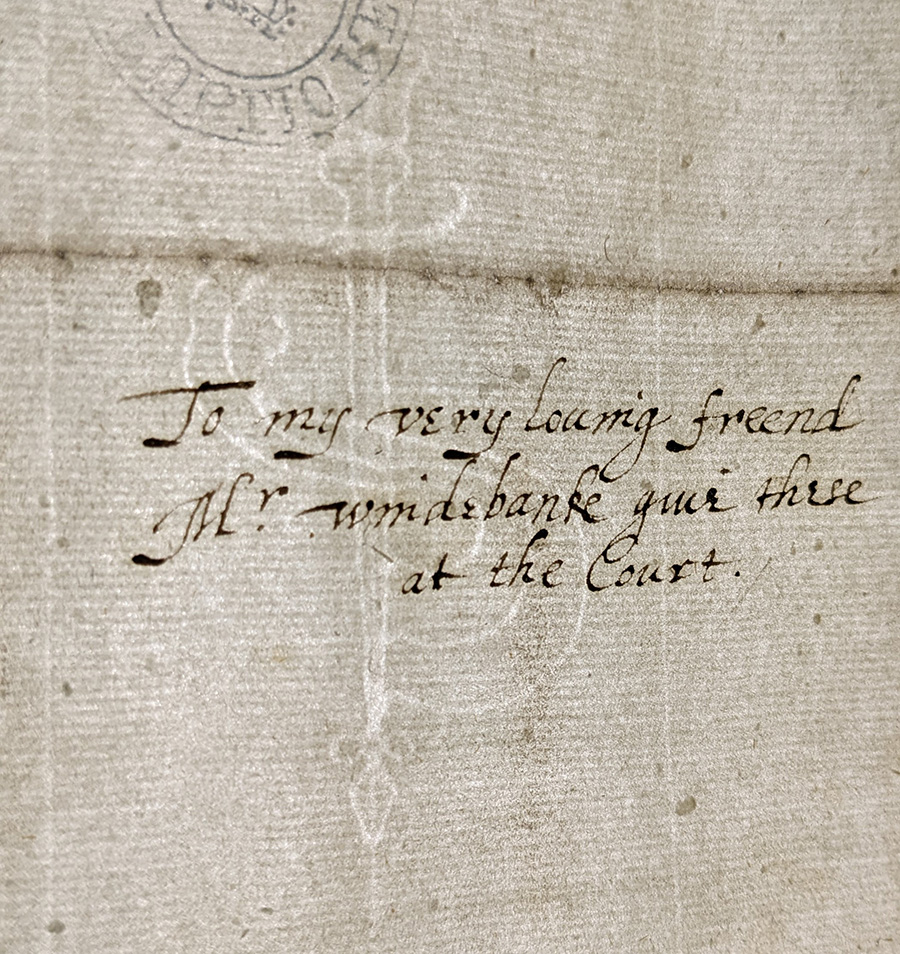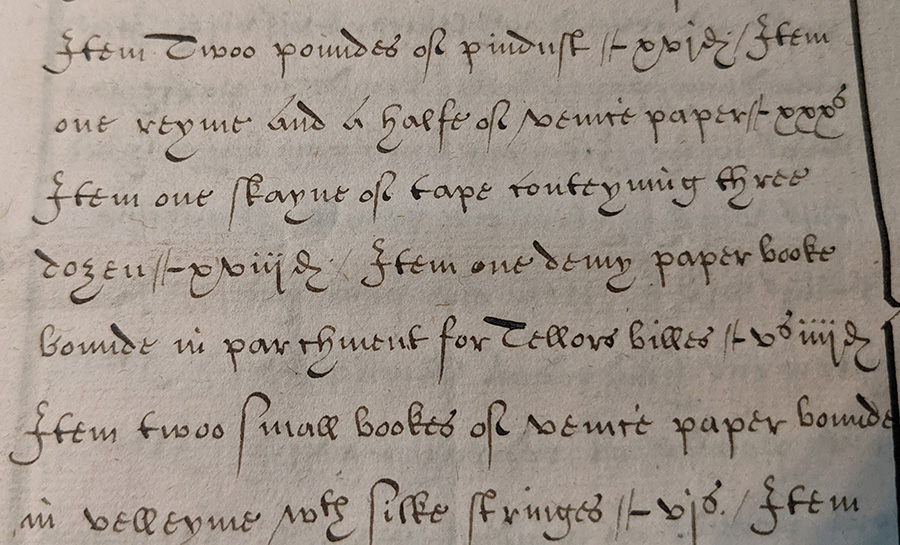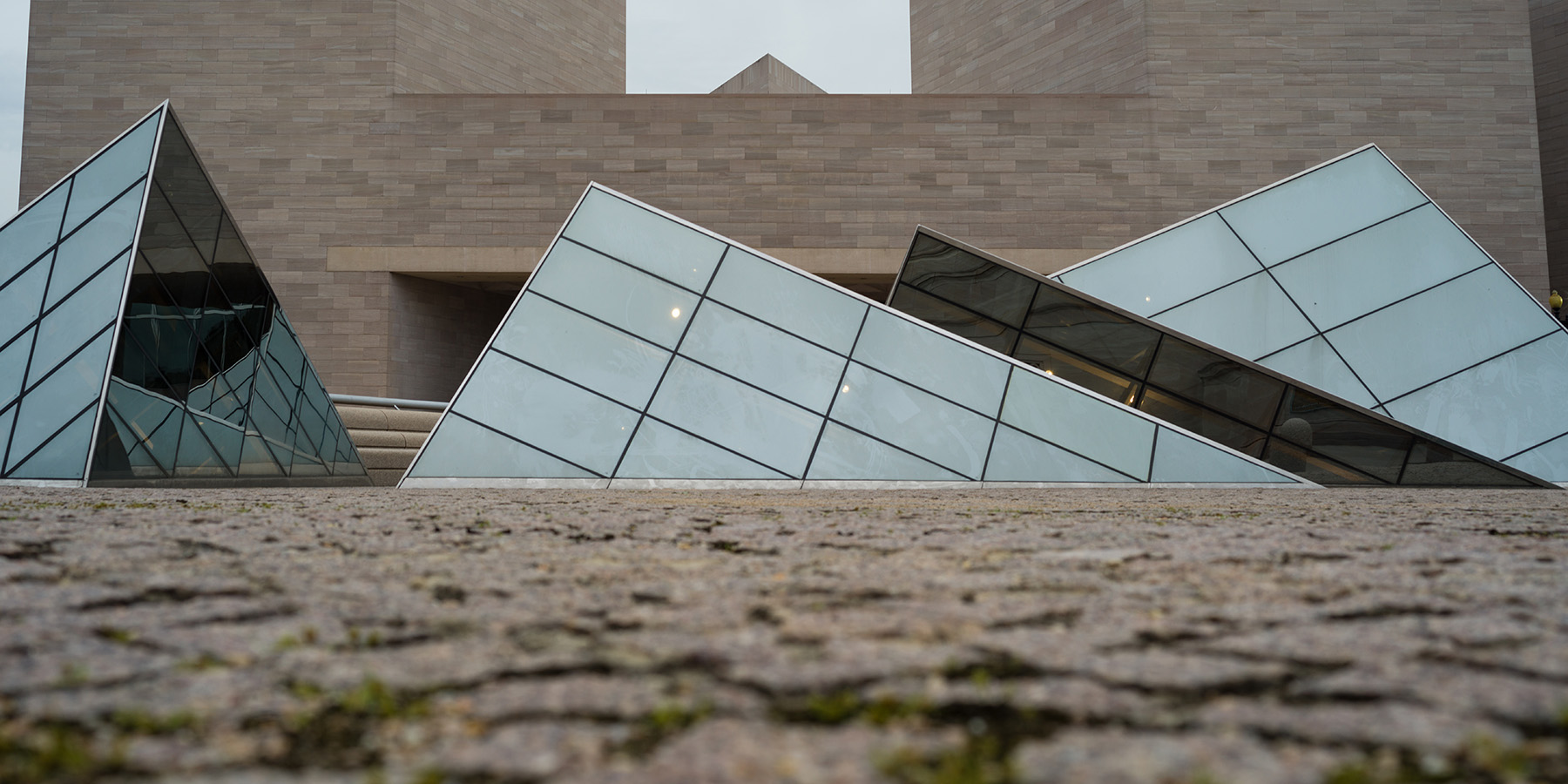Heather Wolfe
Paper Matters: Writing Paper in Shakespeare’s England
“Paper Matters” taps into what readers intuitively know to be true about paper: that it plays much more than a supporting role in textual communication. Despite the digital turn, we possess a tacit awareness and expertise in discerning among dozens of different kinds of paper used in everyday life. Paper sensibility is not a recently developed or innate talent. How we behave around paper and the judgments we make about it have, for centuries, been modeled at home, school, the workplace, and the built environment, and have increasingly been dictated by local government norms and regulations for recycling and disposal.

Detail of watermark on “Venice paper” on address leaf of Lady Anne Neville, autograph letter signed to Secretary Windebank, March 11, 1601, The National Archives, Kew, SP 12/279, fol. 32. Reproduced by permission of The National Archives
In the late 1580s and 1590s, England experienced a writing paper renaissance. Higher-status people began to have access to and to seek out various kinds of writing paper that far surpassed the quality of ordinary paper produced in Normandy, England’s chief supplier. I use an interdisciplinary approach that combines quantitative and qualitative analysis and the tools and frameworks of socio-materiality, book history, and bibliography to tease out this phenomenon and explore the interactions among writing paper, writers, and readers. I treat paper as a commodity resulting from the labor of countless individuals, and as the product of social and economic opportunities and legislation.
The book project challenges the idea that writing paper was an expensive, scarce, and uniform commodity in early modern England, a blank slate subservient to the text inscribed upon it. Through an examination of account books, court records, state papers, and early printed books, I uncover and interpret a rapidly developing vocabulary used by early modern writers to distinguish among different types and qualities of writing paper. I study the paper itself—its translucence, texture, thickness, edges, dimensions, chain lines, laid lines, watermarks, flaws, and other signs of its production—to argue that paper’s multidimensionality was recognized by its consumers, who used paper and text in tandem as a communicative tool. I tell the stories of the people involved in the production and consumption of paper, from the rag-gatherers on the streets of London to the high-status men and women using the finest white writing paper imported from Venice, its gilt edges sparkling in the candlelight of a dimly lit room. Learning to read these signs of early modern paper consumption helps us to better understand the relationship among paper, social status, and genre.
During my two-month fellowship, I developed the chapter “Paper Connoisseurship: Paper Choices and Paper Fashions,” focusing on a variety of writing paper that first appeared in the account books of elite English men and women in the early 1590s: “Venice paper.” Venice paper was much more expensive than ordinary writing paper. It continued to be regarded as a premium writing paper for the next 100 years, longer than any other variety of paper at the time. Its many affordances—its bright creamy color, gilt edges, thinness, translucence, smoothness, and uniformity—made it useful not only as a high-status writing substrate but also as a tool for experimental philosophers and artists. By the 1640s, the unique qualities of Venice paper were described in printed artists’ manuals, scientific books, and chronicles. Its perfection was compared to another commodity that came from the same city, Venetian glass.

Detail from accounts of stationery issued to offices of the Exchequer, including an early mention of “Venice paper,” 1594, The National Archives, Kew, E407/68. Reproduced by permission of The National Archives
I deepened my understanding of Venice paper by connecting manuscript account book entries to printed descriptions and to correspondence written on watermarked paper that could be linked to paper mills in Northern Italy. At the National Gallery, I had access to a rich collection of rare secondary sources on Italian papermaking, and to the expertise of other fellows whose research centered on Venetian art and trade. I learned that Venetian paper often had a telltale countermark in the corner of the sheet opposite the main watermark. Venice paper was sold and distributed in Venice, but it was made in the valleys around Brescia and Bergamo, particularly in the Riviera di Salò on the western bank of Lake Garda, where the mills were powered by the Toscolano River. Although paper was made near many other Italian cities in Northern and Central Italy, including Fabriano and Genoa, English consumers of the finest writing paper refer consistently to Venice paper in their accounts. My working hypothesis is that English consumers began to associate Venice paper with high-quality, gilt-edged paper from all parts of Northern Italy because of Venice’s association in the English imagination with cosmopolitanism, luxury goods, and printed works.
Folger Shakespeare Library
Paul Mellon Visiting Senior Fellow, fall 2022
Heather Wolfe will continue working on her book on a Beinecke Rare Book & Manuscript Library research fellowship before returning to her position as associate librarian and curator of manuscripts at the Folger Shakespeare Library in Washington, DC.
